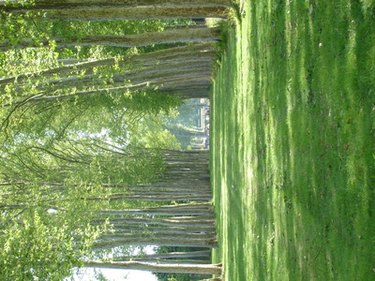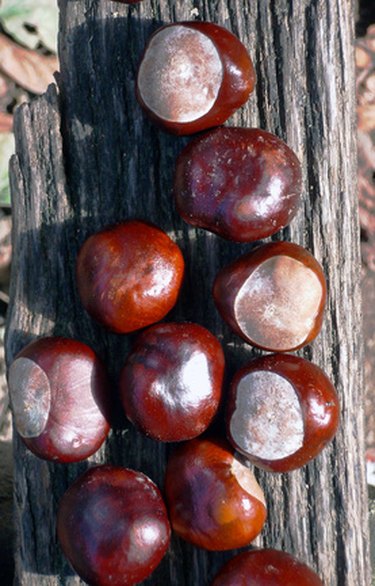
Ohio, the Buckeye State, is home to more than a half-dozen varieties of nut trees, both native and introduced. Nut-bearing trees grow throughout the state. The most famous, the Ohio Buckeye, is the state tree, the source of Ohio's nickname and The Ohio State University's famous symbol. The nickname for the school's athletic teams is Buckeyes.
Ohio Buckeye
Video of the Day

The Ohio Buckeye (Aesculus glabra), an inedible member of the horse chestnut family, can grow to 60 feet in the open. They are more common as smaller understory story trees in western Ohio. Buckeyes thrive in partially shaded environments with moist, well-drained soil. Yellow-green flowers bloom in spring with the tree's early foliage. The small, smooth nut is dark, with a lighter circle on the surface. A buckeye in the pocket is considered considered lucky.
Video of the Day
Yellow Buckeye
Yellow Buckeye (Aesculus flava), also from the horse chestnut family, grows taller than the Ohio Buckeye. Its lightweight wood is used to make furniture, artificial limbs, crates and boxes. Yellow Buckeye is native to Central Appalachia, grows well in full sun and is more resistant to leaf blotch and other problems than the Ohio Buckeye. Nuts are called Buckeye for their resemblance to a male deer's eye.
Butternut
Butternut or White Walnut (Juglans cinerea) is related to the Black Walnut, but much less common. This Midwest native thrives in ravines and moist bottom lands. It's found throughout the state. The sweet, oily fruit was pickled by early settlers and Native Americans boiled it to extract the oil. Butternuts grow to about 60 feet tall, 50 feet wide in the open. Its lightweight wood is beige-pink.
American Chestnut
The American Chestnut (Castanea dentata), once a a staple food for Native Americans and pioneers in Ohio, is a prolific nut producer. American Chestnuts are found mostly in Central Ohio and grow to 80 feet in the open. They also sprout from stumps in the wild, but die quickly there.
Chinese Chestnut
Chinese Chestnut (Castanea mollissima), a member of the Beech family, was first planted in Ohio and other parts of North America after blight devastated the American Chestnut in the early 20th century. Chinese Chestnuts are smaller, growing only to about 50 feet. They produce a nut similar to the American Chestnut.
Hazelnut
Hazelnut or American Filbert (Corylus Americana) grows along Ohio roadsides, in fence rows and at the edge of forests. The nut-bearing shrubs reach about 15 feet, and adapt easily to both wet and dry climates. Hazelnuts, with their male and female flowers, need no outside pollinator to produce fruit.
Shellbark Hickory
Shellbark Hickory or King Nut Hickory (Carya laciniosa) is a Midwest native that produces huge sweet nuts that squirrels love. It thrives in wet areas such as floodplains and bottom lands, and is a hard, dense wood used for construction, furniture, tool handles and firewood.
Horse Chestnut
Horse Chestnut (Aesculus hippocastanum) is an excellent shade tree with its 60-foot span and dense canopy. Its edible nuts are darker and duller than the toxic Buckeye nuts produced by its cousin the Buckeye tree, but otherwise similar. Horse Chestnuts adapt easily to many environments and are found statewide.
Black Walnut
Black Walnut (Juglans nigra) is a quick-growing Midwest native found throughout the state. Industrious squirrels spread and bury the nuts widely. Its hard, lightweight wood is a top choice for furniture, gun stocks, veneer and interior trims. Its edible, oily nuts are commonly used in cooking.